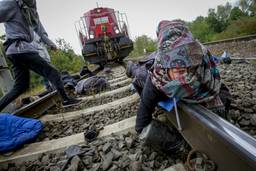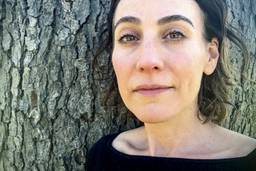What a Night in Border Patrol Custody Taught Me About How We Treat Migrants
I was released from the nightmare of detention--but most are not.
Matthew Leber

On December 10, International Human Rights Day, I was peering through the window of my isolation cell at the Imperial Beach Border Patrol Substation. I could see past a highly secured heavy metal door to a holding cell that contained over a dozen children who ranged in age from five to 15, by themselves without any adult caregivers. Another cell contained women with their infants and toddlers. Another contained men. I could see mothers being fingerprinted while breastfeeding.
I was held in an eight-by-12-foot empty room, with bright fluorescent lights, one metal bench, a metal toilet and a one-inch thick mattress pad. I was told I was being held on the charge of assaulting a Federal Officer, which carried a possible penalty of up to 10 years in prison. I was searched more than four times, and never given an opportunity to make a phone call, even though I requested one several times.
I had not assaulted a Federal Officer. What I had done was help organize a peaceful protest that morning against the very systems of detention and deportation that I was now bearing witness to. Hours earlier, I walked in a solemn procession with hundreds of faith leaders a mile and a half to the U.S.-Mexico border. The event was part of the Love Knows No Borders week of action, organized by the American Friends Service Committee, the Quaker peace and justice organization I work for. When we got to the border, religious leaders from Muslim, Jewish, Christian and Quaker traditions offered a ceremonial blessing to migrants on the other side. We were calling on the U.S. government to respect the human right to migrate, stop the militarization of border communities and end the detention and deportation of immigrants.
At one point in the demonstration, a contingent of Methodists, led by Bishop Minerva Carcaño, waded into the ocean and got down on their knees in prayer. I was standing behind them in support, when a Border Patrol agent grabbed first my backpack, then my body. I felt my arm twisted behind my back and hands squeezing the back of my neck. I heard Border Patrol officers yell, “We got the instigator!” An hour later I was in the cell.
Of course, I am not the first person to be targeted for my organizing, and as a white man and a U.S. citizen, I was shielded from much of what activists of color and immigrants face every day. Organizers like Ravi Ragbir, Alejandra Pablos, Shacorrie Tunkara, Maru Mora-Villalpando and so many others who organize with and for immigrants, are targeted by the government for deportation and imprisonment. These courageous organizers continue to fight for all of our wellbeing, even when faced with some of the most dire consequences.
But activists who are targeted have the benefit — and the burden — of visibility. While their outspoken activism is what garnered repression from the state, the fact that they are public figures means it is more possible to mobilize in their defense. There in the Border Patrol substation, I was with dozens of others whose names are not hashtags, and whose stories the media does not tell.
Every day, migrants from Mexico, Central America and around the world seek refuge in the United States. Many are fleeing violence and poverty that itself is a product of U.S. intervention and destabilization in the region, from U.S. support of corrupt governments — including a U.S.-backed coup in Honduras in 2009 — to funding and training for repressive law enforcement. These conditions force people to make an incredibly difficult choice between the dangers of staying and the dangers of migration. It takes courage to make the long journey for an uncertain future and hostile welcome in the United States.
And while there are many similarities across the migration stories, no two stories are exactly alike.
The morning after my arrest, I was finally taken out of my cold isolation cell, hands cuffed behind my back, and loaded into a cage in the back of a van. On the ride to the Metropolitan Correction Center in San Diego, we stopped to pick up three other detainees — one man from San Francisco, originally from Guadalajara, and two men from Honduras.
Jose*, now in his 30s, came to the United States with his family when he was two years old. This is the only country he knows. About three years ago, ICE detained and deported him to Guadalajara. Eight months ago, his son was born in San Francisco (his partner has papers, so can travel back and forth). He was trying to cross back into the United States to meet his son when Border Patrol agents, dressed in riot gear and holding machine guns, apprehended him. But he told me, “my heart is clear. I might be in prison, but at least I’ll be able to meet my son when they come visit me.”
Javier*, one of the migrants from Honduras who was in his 50s, had come with the caravan hoping to find work in construction. While we rode in the van, he grabbed his knee in pain; it had been shattered from a fall as he tried to cross the border.
Once we made it to the federal jail, I met more men, many with similar stories. We were shackled together, celled together, and arbitrarily moved from place to place, waiting to hear what would happen to us next. Those of us who spoke English would translate for those who did not, as we tried to navigate a complicated and cruel system together.
Around 2pm, an officer called my name and I was brought into three different cells in a 15-minute period, with no explanation. Then, I was given back my clothes and released to the street – with no belt, shoelaces, phone, or wallet. No charges were ever filed against me.
As I stepped out of the cold, repressive jail environment into the sunshine, greeted by friends and colleagues who had been tirelessly advocating for my release, I was struck by the magnitude of injustices facing the men, women and children I had just left behind, and the cruelty of the system that held them captive.
I had come to the border because I believe that now is the time for courageous action. We cannot sit silently as the rights and dignity and lives of migrants are under attack. My brief time in detention only strengthened my resolve.
The men I was shackled with, the families I saw from my cell, should all be out here experiencing the same freedom that I have. And I will keep organizing — alongside the thousands of others who make up this movement — to try and make it so.

I hope you found this article important. Before you leave, I want to ask you to consider supporting our work with a donation. In These Times needs readers like you to help sustain our mission. We don’t depend on—or want—corporate advertising or deep-pocketed billionaires to fund our journalism. We’re supported by you, the reader, so we can focus on covering the issues that matter most to the progressive movement without fear or compromise.
Our work isn’t hidden behind a paywall because of people like you who support our journalism. We want to keep it that way. If you value the work we do and the movements we cover, please consider donating to In These Times.



